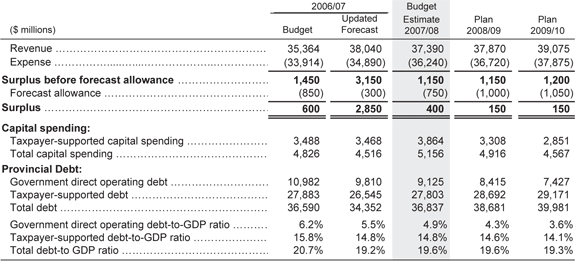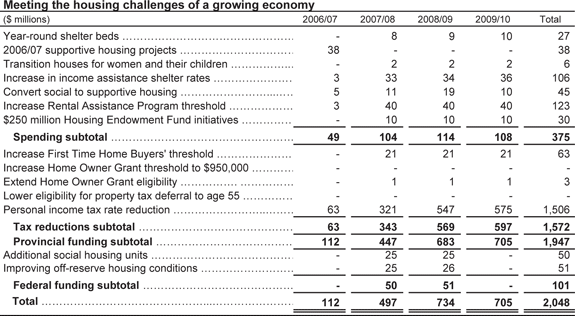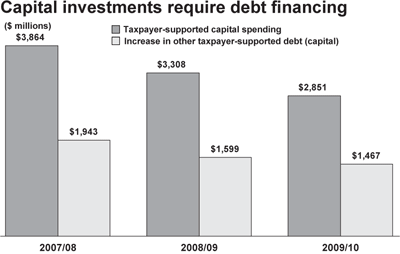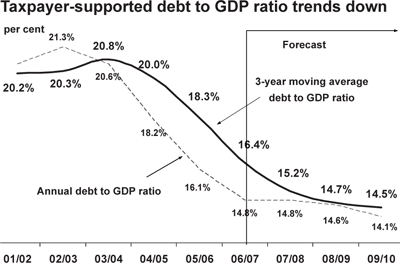Summary

Economic growth remains strong
BC is expected to be one of the growth leaders in Canada over the next few years, fueled by strong consumer and business confidence,
and high levels of residential and non-residential construction. Following estimated GDP growth of 3.9 per cent in 2006, the
BC economy is forecast to grow by 3.1 per cent in 2007. Economic momentum is expected to continue through to 2011 with annual
real GDP growth rates of 3.0 per cent or higher, as the build-up to the 2010 Winter Olympics Games continues.
With broad based strength now evident in the BC economy, employment growth was second only to Alberta for 2006, and BC's annual
unemployment rate fell to 4.8 per cent. In January 2007 BC's unemployment rate was 4.3 per cent, its lowest point in 30 years.

For the last three years, net in-migration to BC has averaged more than 41,000 people a year, with over 35,000 entries from
other countries and net interprovincial in-migration averaging over 6,000 people per year. BC has seen net inflows from all
other provinces except Alberta. Combined with higher incomes, this has created increased demand for housing that has been
reflected in rising home prices.

Budget 2007 focuses on housing
Among the challenges arising from a growing economy is home affordability. Budget 2007 therefore focuses on meeting the housing challenges of a growing economy. The stronger financial position that results from
prudent fiscal management and a thriving economy now enables government to take the following steps towards every British
Columbian having access to a safe, appropriate and affordable home.

More supports for the homeless
To increase access to shelter and supports for the homeless, Budget 2007 increases the number of year-round shelter beds by nearly 300 to a total of 1,300. Increased funding of $27 million over three
years will support these additional beds, as well as counseling services and help to move into longer-term housing.
In addition, $38 million is made available in 2006/07 for supportive housing projects targeted towards people who are homeless,
or at risk of being homeless, providing an estimated 600 beds in shelters, transitional housing and permanent housing.
Budget 2007 also provides $6 million over three years to provide 24/7 staffing in transition houses when required, increasing the safety
of women and their children who have left abusive relationships, and providing additional crisis assistance and support.
Enhancing Income Assistance
Budget 2007 contributes $106 million over four years to increase the shelter rate for people on income assistance by $50 per month, providing
recipients greater access to the housing market; or allowing them to spend support money on food and other necessities rather
than on shelter costs.
In addition, government is standardizing shelter and support benefits for families with children, so that all parents — whether
employable, with a disability, or with persistent multiple barriers to employment — receive the same supports for their children.
Converting social to supportive housing
Recognizing the increased demand for supportive housing primarily from lower income seniors, Budget 2007 provides $45 million over four years to upgrade up to 750 social housing units to supportive units, enabling seniors to remain
in their communities longer.
New support for working families
Budget 2007 raises the Rental Assistance Program income threshold to $28,000, making over 20,000 lower income working families renting
in the housing market potentially eligible for direct assistance.
Improving housing affordability
Budget 2007 includes tax changes to help British Columbians with the rising cost of housing:
- The threshold for the First Time Home Buyers' Program for property transfer tax exemption will increase to a province-wide
standard of $375,000 and there will be greater access to the program for families acquiring Habitat for Humanity homes;
- As announced in January 2007, the Home Owner Grant phase-out threshold will rise to $950,000 to ensure that more than 95 per
cent of homeowners continue to be eligible for the full grant;
- The Home Owner Grant will also be available to low income seniors, veterans, persons with disabilities, and other qualified
individuals regardless of the assessed value of their home;
- Eligibility for the Property Tax Deferment Program will be lowered to age 55 years from the current 60; and
- Budget 2007 builds on previous reductions to the personal income tax rate by providing a 10 per cent cut to provincial personal income
taxes for people earning up to $100,000. Reductions to personal income taxes since 2001 mean that 250,000 British Columbians
now will pay no provincial income tax, while lower income taxpayers have seen reductions of up to 70 per cent. Most taxpayers
have seen reductions of between 30 and 35 per cent. The additional money in people's pockets will help British Columbians meet
their housing challenges, and help them with the high cost of housing in BC.

$250 million Housing Endowment Fund
Several years of robust economic growth, prudent fiscal management, and a sustainable debt track have provided additional
financial flexibility, enabling government to set aside $250 million out of the $2.85 billion 2006/07 surplus to establish
a Housing Endowment Fund. This amount will be invested and generate an estimated $10 million annually in perpetuity. These
earnings will be available to support innovative housing proposals to focus on new ways to meet the diverse needs of individuals
and families not being fully served by existing programs and services.
Sustaining Services to British Columbians
Budget 2007 also commits funding to sustaining and enhancing health, education and other key services on which British Columbians depend.
Budget 2007 provides:
- Additional funding for healthcare and K–12 education totalling $1.4 billion over three years, excluding funding for settlement
costs under the negotiating framework. Including funding for negotiating framework costs results in total funding increases
of $3.3 billion;
- $468 million over four years invested in programs that enhance the quality of life for children, adults and families, and
are targeted towards children at risk or with special needs, adults with developmental disabilities, and individuals or families
in need;
- An additional $178 million over four years to improve and transform the policing, justice and correction system to protect
communities and citizens;
- $189 million to strengthen BC communities through local infrastructure and transportation projects;
- $315 million over four years to enhance post-secondary educational and training opportunities throughout the province, reconciliation
of Aboriginal rights and title, and investments in the natural resource sectors; and
- $103 million for environmental leadership initiatives that protect the environment, and support sustainable environmental
management and includes the following tax changes:
- Provincial sales tax relief for the purchase of hybrid vehicles will be extended to April 2011;
- The exemptions for ENERGY STAR furnaces, boilers and heat pumps will be extended; and
- The exemption for alternative fuels will be expanded to include all biodiesel fuel.
Additional tax reductions
Budget 2007 also provides $303 million over four years to improve the competitiveness and fairness of the tax system including:
- Implementing the training tax credit to help ensure BC's young people have the skills they need;
- Implementing an enhanced dividend tax credit to reduce the extent to which income is taxed at both the corporate and personal
level;
- Extending the Book Publishers tax credit for an additional 5 years to 2012;
- Extending the provincial Scientific Research and Experimental Development Tax Credit until 2014;
- Enhancing the Mining Exploration Tax Credit in areas affected by the Mountain Pine Beetle; and
- Providing a tax refund on the purchase of eligible medical equipment purchased by charities.
Building universities, hospitals and roads
The higher than expected surpluses over the past few years have allowed the province to make significant investments in infrastructure
without adding to provincial debt. For example, the $3.06 billion surplus in 2005/06 and the $2.85 billion surplus in 2006/07
helped finance the following:
- $1.61 billion spending on post-secondary facilities including the University of Victoria's Engineering and Computer Science
Building, and the North Cariboo Community Campus in Quesnel;
- $0.65 billion spending on the K-12 school system including Pacific Heights Elementary school in Surrey, and L'Ecole Victor
Brodeur in Esquimalt;
- $1.70 billion for health facilities and equipment including cancer treatment vaults at the BC Cancer Agency's Vancouver Centre,
and the Mental Health Building for Children at BC Children's and Women's Hospitals; and
- $1.60 billion for roads and bridges projects including the Cariboo connector program, Kicking Horse Canyon Phase I, and Yoho
bridge.
BC continues to invest in building and upgrading schools, universities, colleges, hospitals, roads and bridges to meet the
needs of a growing economy, with just over $10 billion forecast to be invested in taxpayer-supported capital spending over
the next three years. However, borrowing for capital purposes is forecast to increase by a smaller $5 billion over the same
period, as cash and cost-sharing with partners reduces borrowing requirements.

Recognizing that higher than expected construction costs are an ongoing concern, and that several key health projects are
still in the review phase, the government has increased its capital contingency to an average of 9.5 per cent of total taxpayer-supported
capital spending over the next three years. This contingency is in addition to the contingencies included in individual project
budgets, and is estimated to be sufficient to accommodate these pressures within the overall capital plan forecast.
Debt remains affordable
Although taxpayer-supported debt is forecast to grow an average 3.2 per cent annually over the next three fiscal years, reaching
$29.2 billion in 2009/10, this growth is managed through debt allocations for each sector, so that growth in debt is less
than the growth in the overall economy.
The taxpayer-supported debt to GDP ratio, a key measure of fiscal sustainability used by credit rating agencies, is therefore
forecast to decline over the next three years. However the decline is flat in 2007/08 and modest in 2008/09 reflecting higher
capital spending levels and smaller surpluses in those years.

Government is committed to maintaining a downward trend in the taxpayer-supported debt to GDP ratio. Consistent with the recommendations
of the Economic Forecast Council, a moving average is used to track the debt to GDP ratio trend. This strategy keeps debt
affordable for future generations of British Columbians.
Forecast allowances cover risks and pressures on the fiscal plan
The forecast surpluses for 2007/08, 2008/09 and 2009/10 included in Budget 2007 remain the same as those set out in November 2005 when the negotiating framework for public sector compensation was established.
As settlements covering approximately 94 per cent of the public sector have since been concluded, these negotiated wage increases
have now been included in ministry budgets. Combined with funding for service enhancements provided in Budget 2007, this provides a sustainable spending plan for the next three years.
The main risks to the fiscal plan lie in the potential for a larger than expected slowdown in the US economy; the volatility
of commodity prices, in particular natural gas and lumber prices; and the Canadian dollar. As well, while the fiscal plan
assumes the status quo for federal government policies regarding taxation and transfer payments to the provinces, these could
change in the forthcoming federal budget. The main spending uncertainty, other than from natural disasters, rests with the
interim nature of health authority funding amounts for 2008/09 and 2009/10. The size of forecast allowances for those years
recognizes the need to accommodate some additional growth in health authority funding, as well as the above noted risks.